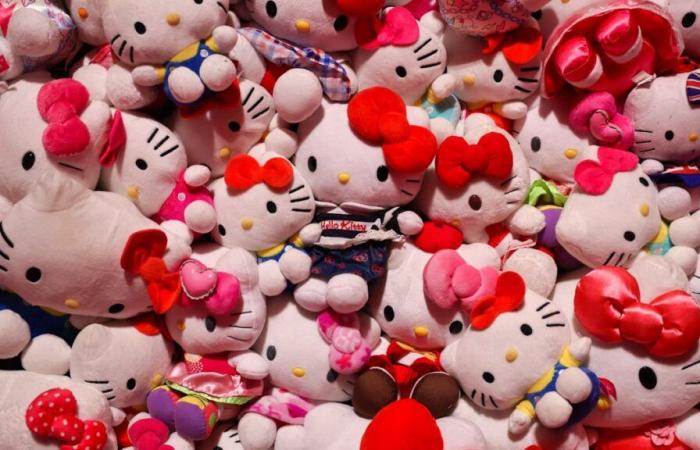The quintessential incarnation of the kawaii (cute) side of Japanese popular culture, Hello Kitty celebrates its 50th anniversary on Friday – and continues to enrich its Japanese creators.
Created in 1974, the figurine, which looks like a white cat wearing an eternal red bow, is a global success: its face is displayed everywhere on tens of thousands of products, from soft toys to schoolbags, from clothing to household appliances. The character with schematic features – a little girl from London and not a cat, assures the Japanese group Sanrio which exploits the license – has a solid fan base which makes it a profit machine.
In California, Helen has set up an entire room to store her thousands of stuffed animals and objects bearing the image of the enigmatic Kitty, including glasses, an armchair, chewing gum dispensers…
“We tell people my age that it’s for children, that makes me laugh,” laughs this fifty-year-old American, who drives an SUV emblazoned with the character and runs a local fan club.
She says she has been “obsessed” since the character arrived in the United States in the 1970s, ensuring that the hours spent among his stuffed animals “soothe the child” in her. At first, Hello Kitty illustrated a purse, then over the decades, she appeared on very heterogeneous items, official or not, until being associated with brands like Adidas and Balenciaga.
A film in preparation
Its popularity is not running out of steam: a Warner Bros. film is being prepared, a new theme park will be dedicated to it next year in southern China.
Since the young Tomokuni Tsuji succeeded his grandfather as general manager of Sanrio in 2020, the company has seen its share price increase sevenfold, to exceed the equivalent of 6 billion euros in market capitalization .
“It would be stupidly cynical to say that we have no need of these soft, fluffy, pink things. Given the disjointed nature of our contemporary lives, we perhaps need it more than ever,” Christine R. Yano of the University of Hawaii told AFP. “This is not a phenomenon that is over or about to become so, at least in the short term,” predicts the anthropologist, author of an essay on Hello Kitty, “Pink Globalization.”
Mouth missing
Unlike other Japanese cultural exports, Pokemon or Dragon Ball, Hello Kitty has never been the subject of a particularly developed narrative universe.
According to Sanrio, he has a twin sister (Mimmy), a boyfriend (“Dear Daniel”) and a pet cat. She loves apple pie and dreams of becoming a pianist – or a poet.
But the rest is a blank page left to the imagination, like “abstract and stripped-down graphics, endowed with a simplicity and elegance that can speak to the greatest number of people”, underlines Christine R. Yano, evoking a “virgin product”.
Some feminist commentators felt that Hello Kitty’s lack of a mouth, preventing her from expressing herself, symbolized disempowerment. On the contrary, “it allows us to reflect” different emotions, counters Yuko Akiyama, head of global brand management at Sanrio. “If you are sad, Hello Kitty comforts you. When you are happy, she shares your happiness.”
Celebrity Sweetheart
Celebrities who love Hello Kitty are legion, from singers Lady Gaga, Nicki Minaj and Katy Perry, to British monarch Charles III. The TikTok account dedicated to the character, established as “patron saint of the super-adorable”, delights 3.5 million subscribers with memes or photos of appearances during American baseball competitions.
Note that Sanrio owns the copyright to hundreds of other characters, and Hello Kitty only represents 30% of profits today, compared to 75% ten years ago.
(afp)






